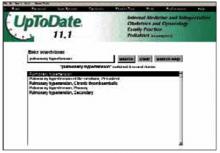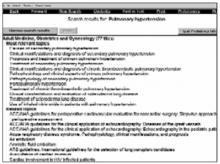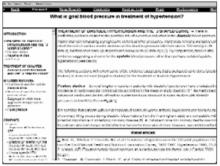How many clinical questions arise during an average day at the office? How many more questions might one entertain if clear-cut, expert advice were seconds away? Enter UpToDate, an electronic clinical database for, well, acquiring up-to-date clinical information—plus continuing medical education (CME) credits and patient handouts.
Unlike a textbook, UpToDate is not set up for paging through content from beginning to end. Rather, it is designed for searches that yield lists of relevant monographs. UpToDate’s initial screen displays simple menu bars and a prominent search box (Figure 1). The next step allows one to narrow the search (Figure 2).
Per its educational objectives, UpToDate provides “instant access to the most current clinical information and recommendations on patient care and treatment,” yet is “comprehensive” from “physiological concepts through results of the most recent clinical trials and protocols.” Each monograph indicates when the literature was last reviewed and the document updated. The service is available in 3 formats: personal computer-based, online, and Pocket PC. We reviewed these formats using Windows PCs.
FIGURE 1
UpToDate’s main screen
Main search screen after entry of search term “pulmonary hypertension” and performing the initial search.
FIGURE 2
Typical UpToDate search screen
List of monographs retrieved after clicking “Pulmonary hypertension” from the list in Figure 1 Note that “Find in Text” is not active, but an option to “Narrow search results” results in a secondary search screen. Users selecting this option may then either enter a term in the secondary search box or choose among a list of “modifiers” that vary by topic.
Testing uptodate in a clinical context
Following are a few questions that needed answering during a half-day of practice:
- How effective is topical terbinafine (Lamisil) in treating Candida skin infections?
- What is a reasonable algorithm to determine the cause of chronic renal failure?
- How does one compound nitroglycerin ointment to treat an anal fissure?
- What is the latest thinking on interstitial cystitis?
- What is the preferred empiric antibiotic therapy for presumed bacterial conjunctivitis in adults?
- Does efficacy differ between injectable and intranasal forms of calcitonin for relief of pain from osteoporotic vertebral compression fractures in postmenopausal women?
UpToDate answered 4 of the 6 questions quickly, requiring no more than a few minutes for each search. We found that 2% nitroglycerin must be diluted to 0.2% for use on anal fissures. We also obtained summarized information on interstitial cystitis, a treatment recommendation for conjunctivitis, and data regarding the efficacy of calcitonin administered by either of 2 routes. The information generally was excellent.
More difficult searches
Testing UpToDate further, we searched for less common maladies. We found 4 sentences on proctalgia fugax that, remarkably, seemed to cover the topic adequately. Transient global amnesia was covered tersely (3 sentences) but, again, adequately. Restless legs syndrome was covered well, in several paragraphs, although drug therapies were discussed in random order rather than by drug of choice. Piriformis syndrome was covered inadequately, and presbyesophagus was not listed at all.
Controversial topics
Subsequent searches yielded excellent discussions on controversial topics. Many monographs lend themselves best to leisurely reading, but they could also be used at the point of care. For example, the controversial diastolic “J-curve phenomenon” in treating hypertension is covered in about fourteen 2- to 6-sentence paragraphs. A summary appears first, typical of UpToDate’s style (Figure 3).
This section on diastolic blood pressure is subdivided into “Positive studies,” “Negative studies,” and the “HOT trial.” Users may jump directly to the “HOT trial” summary by clicking on that title on the left window. References appear in a text box at the bottom of the screen. The relative sizes of these 3 windows may be changed by grabbing and dragging the lines dividing them.
FIGURE 3
Typical UpToDate monograph
Users can minimize the left-hand and bottom panes to have a larger main text pane. Although not marked like typical hyperlinks, clicking any reference in the text window pops up that reference and, if available, its abstract. Clicking any subheading in the left-side outline pane transports the user to that section (eg, “HOT trial”). Clicking “Recent Topics” on the upper menu bar produces a list of the last 20 sections visited. Revisiting a topic is then possible with one additional click.
Drug mentions
Drugs mentioned in UpToDate are hot-linked to the corresponding Lexi-Comp drug information monograph, which is “intended to serve as a rapidly accessible, concise initial [drug] reference resource.” UpToDate/Lexi-Comp does not provide guidance regarding cost of drug therapies.
Notable Features
Graphics
When the user clicks on a graphic’s link in the text, a figure, table, or picture is superimposed on the text. The image disappears when the user returns to the text.




